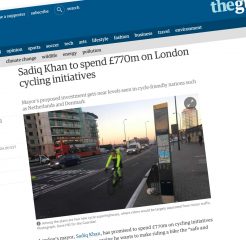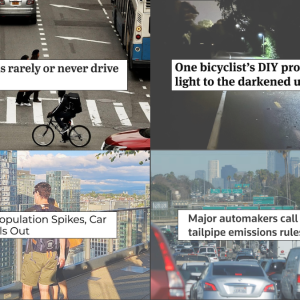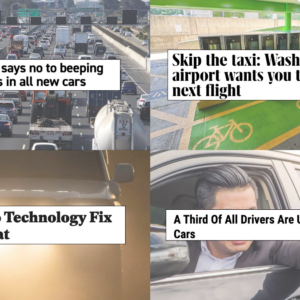
This week’s Monday Roundup is brought to you by Western Bikeworks who reminds you to check out their big warehouse sale coming December 9-11th at their Tigard location.
Lots of fun stories to share this week so let’s get right to it.
Here are the best stories we came across last week…
The Portland “megaregion”: A mapping project highlighted by National Geographic holds important clues about geography and mobility. Can someone tell me why we don’t have high-speed trains along I-5 corridor yet?
Deal with the devil: The head of the once-influential National Motorists Association appears reasonable in this Q & A professing support of a gas tax increase — them he says he wants to raise speed limits and get rid of speed cameras.
More from the auto lobby: DC Transportation Engineer Bill Schultheiss tracked down this influential 2006 report (PDF) from the American Highway Users Alliance that was used to lobby politicians for more highway capacity on the premise it would be necessary for successful evacuations in emergencies. Right… because private auto use is the most efficient way to move large numbers of people. Got it.
Traffic on purpose in NYC: Looks like the NY Post has joined in the national trend of publishing fake news with a story claiming that traffic in Manhattan is nothing more than a conspiracy by anti-car lobbyists to force people onto bikes and transit.
Real skin in the game: Elected officials in the Canadian city of Hamilton have brought up bicycle licensing during a debate about infrastructure funding so that riders have “skin in the game” — even though the debate started after a woman was hit and killed while riding on a dangerous street.
Cyclist IDs? Umm no: Electeds in Sydney are just the latest leaders to come to the realization that schemes like licenses or special ID tags for cycling are much more complicated and ill-advised than they seem.
Why bike licensing is a bad idea: In case you need to brush up on your arguments, CityLab breaks it down for us.
Biking YouTube celeb: Famed NYC filmmaker Casey Neistat — known for his videos of riding a bike through Hurricane Sandy and car doors — has sold out to CNN. Hopefully be brings his bike to his new office.
Advertisement
Speed related deaths: Glad to see that Portland isn’t on this list of cities with the most speed-related fatalities.
“Driver mode” for phones is good for business: Even the very pro-business magazine, The Economist — which is read by the most powerful people in the world — believes that ignoring your phone while you drive is a very good idea.
Lessons for Washington County?: This profile of a suburban area outside Washington D.C. asks an important question: “What happens when people without cars move to places built for driving?”
Vision Zero in neutral: Not a good sign in NYC when Mayor Bill de Blasio says Vision Zero “has just begun” when in fact he kicked off the effort over two years ago. This is the peril of Vision Zero — it gives politicians a powerful political tool and photo-op while not mandating any tangible actions.
Trump’s Transpo Sec: CityLab has a breakdown of what we can expect from Elaine Chao, Trump’s pick for Secretary of Transportation.
Reason to worry about Chao: The trucking and auto industries seem to like the Elaine Chao pick. That’s not a good sign for transportation reformers.
Biking boom in London…: A new report shows a massive jump in cycling traffic in London — in no small part due to a commensurate jump in protected bikeways.
… And it will continue: London’s mayor has pledged a whopping $1 billion investment to continue investment in infrastructure designed specifically to boost cycling rates. The money would give London similar per-capita cycling spending as the world’s best cycling cities in the Netherlands and Denmark.
Serious about sidewalks in L.A.: The $1.4 billion investment in sidewalks announced in Los Angeles sounds like a lot — until you realize that city has neglected them for 40 years so it has a lot of catching up to do.
Tokenization and coalition-building in a mostly white world: A report from The Untokening summit last month details a panel discussion where black leaders discussed the challenges of working in the bike advocacy sphere.
Distracted deviant: A 20-year-old man was using Facebook Live to show his speed at 115 mph just before he crashed into a truck.
TWEET OF THE WEEK
I went with @SHAQ to #ShopSmall for holiday gifts. A bond was formed over three wheels. #AmexAmbassador pic.twitter.com/D02r16FT8h
— Wanda Sykes (@iamwandasykes) December 1, 2016
Thanks to everyone who helped us find these gems.
— Jonathan Maus, (503) 706-8804 – jonathan@bikeportland.org
BikePortland is supported by the community (that means you!). Please become a subscriber or make a donation today.





Thanks for reading.
BikePortland has served this community with independent community journalism since 2005. We rely on subscriptions from readers like you to survive. Your financial support is vital in keeping this valuable resource alive and well.
Please subscribe today to strengthen and expand our work.
Live streaming your 115 mph car crash? Florida man? ¡¿Rhode Island man?!
I suspect that the increase in bike use in London has as much to do with congestion pricing and increased enforcement (remember last week’s round-up article about car-crushing for motorists who pass unsafely more than once?) as with the building of more bikeways.
As always, trends in bicycle use, both up and down, are complicated to sort out for causes. Does the cultural change that makes it okay to not be in a car lead the way and cause demand for better conditions, or do improved conditions bring about cultural change, or is it just a spiral (up or down) where each reinforces the other until some inevitable push-back? Certainly in the former bicycle capital of the world it was cultural change that led the way, but that was one place at one time.
That is a factor, but I have read recently that vehicle traffic levels have increased to the point they were at before the pricing scheme started. You also have public transit at near-capacity, so many opt for cycling because the busses and tube are full. Ultimately, this is all good news. More cycling infrastructure means more options. Some trips will still be best via transit, some by bike, and even some by car.
Jonathan – typo check: ” the[n] he says he wants to raise speed limits and get rid of speed cameras.”
My primary concern with Chao is that when the regulatory structure for autonomous cars is put in place, will she allow the car companies to prioritize speed over safety? Will she indemnify them against lawsuits, particularly class-action, for the preventable deaths of cyclists and pedestrians? Once this stuff is in place, it will be frighteningly difficult to amend them in ways that protect and promote active transportation.
I have been impatiently awaiting autonomous cars for their promise of better safety. Now I’m half hoping that they will be delayed a bit.
I lived in NYC during much of the Bloomberg administration. I would take anything printed by the NY Post with a grain of salt, similarly any statements made about road traffic by any member of the NYPD. Mayor Bloomberg did wage a war on traffic. Some of the things that annoyed him included city employees using flashing lights on their city cars to get through traffic quicker (he had the lights removed from most city cars), “parking placards” issued by city agencies to their employees (essentially giving all employees free parking 24/7/365 throughout the city) and NYPD officers ignoring traffic laws when driving/parking. I lived near a NYPD building, the streets around it were congested with the private automobiles of police officers/employees – they even had parking spaces painted onto the sidewalks. As far as I was concerned, city employees should have been taking the subway/bus to work like everyone else (including Mayor Bloomberg), or been paying for parking. Most of those city employees did not need to drive to work. I had a NYC teacher tell me that they didn’t get many perks so the parking placard was well deserved – given that NYC employees had the best medical insurance, teachers have life tenure and higher than average incomes I was a little cynical about her response.
I agree that the I-5 corridor should have high speed trains, but at this point I’d settle for just getting what we had eighty years ago when over a dozen trains each way moved between Eugene and Portland. (Actually, they moved from Eugene to Salem and from Salem to Portland, but the effect was the same.)
Just in case anyone thinks we’re moving along in that direction, just last year the legislature almost unfunded the Amtrak Cascades line. Poor though it is, it’s all we’ve got. I think the price tag is something like $3M annually. Of course there’s plenty of money for fooish freeway expansions that cost tens and hundreds of millions (or more).
[Medium] speed rail service Portland to Eugene is a no brainer…I wish we had true “high speed” service…vs. our current 1880s level “high speed” service…
To be more specific, ” just last year the [OREGON] legislature almost unfunded the Amtrak Cascades line”, I am assuming you were writing about Oregon…since their support for local Amtrak service has wavered in the recent past…Washington State has not had this deep of a problem…and WSDoT almost took the borrowed 2 Cascade trainsets back from Oregon that last time Salem baulked at funding local service.
http://portlandtribune.com/pt/9-news/264390-137611-legislators-keep-punching-amtraks-ticket-for-now
If the U.S. is going to have high speed train lines, on the west coast, thought should be given to a line running from the U.S./Canadian border all the way down Oregon’s southern border and on into California and down to L.A. May as well think big where high speed trains are concerned. I forget the name of the asian country about whose major high speed train line through a major mountain, was covered in a documentary film, but such engineering challenges can be met.
The pres elect might be intrigued by the idea. Linking together by high speed rail, the major economic centers of the west coast. He’s expressed his interest in working to have the U.S. once again be the best in the world, in everything. Part of the way to do that may be to set forth in starting to build the worlds’ greatest interstate high speed rail system.
The distance between Eugene and Sacramento is too far and would be too expensive to build true HSR due to the topography. We should push for 110mph service between Portland and Seattle, with trains every hour during the day. This can be done with existing equipment and a 3rd mainline, combined with crossing improvements. Between Portland and Eugene, we need to utilize smaller, lighter European trains, which should soon be allowed by new Federal rules:
https://en.wikipedia.org/wiki/Stadler_FLIRT
Portland – Eugene needs service every 2 hours during the day, at 90mph, which will require a second main line for the full corridor. Using smaller/lighter trains will reduce operating costs and allow for additional service.
ODOT had the opportunity to build a dedicated line for Portland-Eugene, but opted to use the existing freight line due to cost. Though this decision technically is not yet final, it’s not likely to be reversed. Funny how they were willing to shell out billions for the CRC, but not for rail…
I don’t think Trump has transportation policy first in mind with the selection of Elaine Chao for transpo secretary. I hear it as a big juice kiss planted by the Donald on Mitch McConnel’s ass.
“The trucking and auto industries seem to like the Elaine Chao pick. That’s not a good sign for transportation reformers.”
Eh. That’s pretty standard, generic praise they offer up. I don’t see anything revealing there. Every lobby/business group says the same thing about every appointment. Obviously when you go to your first meeting and are asking for help, you hardly want the new Secretary to have seen that you already said something bad about them in the press.
To be clear, I’m not excited about the nomination, but the boilerplate “praise” doesn’t move the needle for me.
I’m amused by Trump’s plan to “privatize” upgrades to the nation’s highway infrastructure. Use tax cuts to get private industry to invest in new highways, then charge tolls, and if the tolls don’t generate enough profit beyond the break even point, taxpayers will pick up the difference.
Hey! Just like PERS
The National Geigraphic map is interesting. It suggests that the Portland metro area be thought of as extending down I-5 all the way to Ashland, and Seattle’s from the Canadian border to Vancouver, WA. That makes a pretty strong case for a national bike route running along the I-5 corridor all the way to San Diego, and for expanded rail service from Eugene to Vancouver, BC.
I like the megaregion concept that’s been splashed all over the interwebs this week – in concept. I think the boundaries still need a bit of fine tuning, based on both traffic patterns and cultural connections.
– I don’t see the case for a “Columbia Plateau” megaregion combining Spokane and Boise. It actually takes longer to drive between these two cities than it does to drive from either one to Portland or Seattle. If anything, Spokane is at least as strongly connected to western Montana than it is to southern Idaho, and could probably be combined with Missoula, Butte, Helena, and maybe even Billings as a “Great Northern” megaregion. That, or Spokane (along with Tri-Cities, Yakima and Wenatchee) could be combined into the Seattle megaregion, to which it has stronger economic ties than it does to Boise.
– I’d put most of southeast Idaho into the Salt Lake City megaregion.
– Are Medford/Ashland/Grants Pass really more strongly connected to Portland than to northern California? Seems these could go in the NorCal (aka “State of Jefferson”) region more credibly, otherwise I’m not sure the Eureka/Arcata/Redding zone is big enough to qualify as a megaregion.
– Does Reno really get its own megaregion? It’s pretty strongly connected to what’s usually known as “northern” California, and probably belongs in the Bay Area gigaregion.
– I wouldn’t disagree with most of the boundaries here in the Upper Midwest, except I don’t think the sparsely populated Upper Peninsula really qualifies as a megaregion either. Culturally and economically most of the UP belongs in the Milwaukee/Madison megaregion, except the eastern tip which would go into the Detroit/Toledo megaregion.
Of course the whole megaregion concept is predicated on a massive amount of mobility, largely fueled by subsidized car transportation. We may expect to see wane this in coming decades, but this concept will still be useful in building our future regional transportation networks.